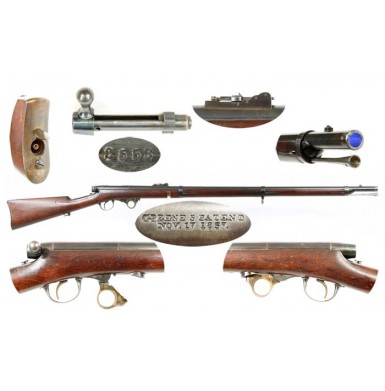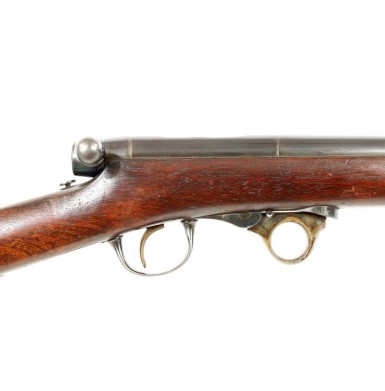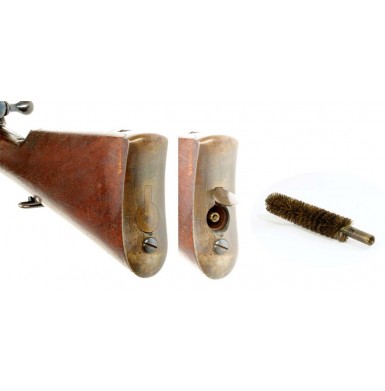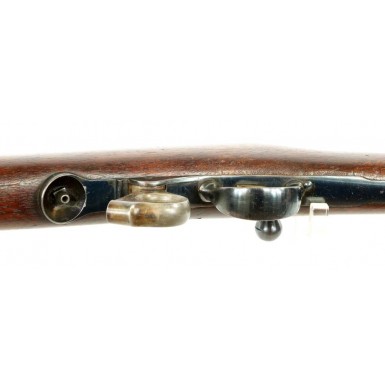James Durrell Greene was an innovative and forward-thinking man who had a distinguished career in the US military, but is probably best known for the two breechloading military firearms that bear his name; the Greene Rifle and the Greene Carbine. Although the arms were moderately successful at best, Greene managed to secure US military contracts for both models during his career and can be credited with designing the first bolt-action rifle to be purchased by the US military.
J.D. Greene was born on May 12, 1828 in Lynn, MA. He was the son of James Diman Green, who was an ordained minister, and who also served as the first mayor of Cambridge, MA. James Durrell later added the extra "e" to his last name to help distinguish himself from his father, as their first names and middle initials were the same. James Durrell grew up with the dream of having a military career and hoped to attend the US Military Academy at West Point. However, his mother objected, so instead he attended Harvard, where he graduated with a Master of Arts degree in 1853. While at Harvard he joined the local Cambridge militia regiment, the Cambridge Guards, and rose to the rank of Captain. This was the beginning of his military career. In July of 1860, as the clouds of war began to gather, he joined the 4th Massachusetts Volunteer Militia as their Lt. Colonel. Greene would subsequently serve during the course of the American Civil War as the Lt. Colonel of the 5th Massachusetts Volunteer Infantry from May-June 1861, as the Lt. Colonel of the 17th US Infantry (Regular Army) from June 1861-September 1863, and as the Colonel of the 6th US Infantry (Regular Army) from September 1863-June 1867. In 1867 Greene would retire from the US Army with the rank of Brevet Brigadier General. While serving with the 17th US Infantry, Greene participated in some of the most horrific battles of the war, including Antietam, Fredericksburg and Gettysburg. While with the 6th US Infantry he saw combat at Chickamauga, and after the war saw reconstruction service with the regiment in Georgia and South Carolina.
While he was a capable and efficient army officer, Greene's passion appeared to have lain in the development of firearms. Greene received his first firearms design patent on January 3, 1854, US Patent #10,391 for a breech-loading firearm. He followed that up a few months later with his second firearms patent, #11,157, received on June 27, 1854 for an improvement to breech loading carbines. These two patents became the basis for his breechloading Greene Carbine. Greene managed to receive a small US Ordnance Department contract for the carbines, and 300 were purchased by the US military around 1856. As Greene had no ability to manufacture the arms, the guns were produced under license by the Massachusetts Arms Company. Although his US success with the carbine was quite limited, Greene did receive an additional order for 2,000 of the guns from the British military. Greene's next design would also prove more successful with foreign governments than with the US government as well. On September 8, 1857 Greene received US Patent #18,134 for the Greene Cartridge, which was uniquely designed with the bullet behind the powder and wad. That same year, he received US Patent #18,634 on November 17, 1857 for his bolt-action rifle that was designed to utilize the unique cartridge. The Greene Rifle was a truly revolutionary design in the field of US military firearms. Not only did the gun utilize a bolt to actuate the breech loading action, it also utilized an underhammer ignition system and an oval bore. The bolt system was complicated by today's standards; as the bolt had to be operated twice in order to load the gun. Pressing a small round release behind the bolt unlocked it and allowed the handle to be rotated upwards 90-degrees and the bolt drawn to the rear. A cartridge was then placed in the open breech, and the bolt slammed home. The bolt was of a two-piece design, with an outer section that included a pair of locking lugs, and a separate inner section that functioned as a rammer. Pushing the bolt forward made the rammer extend from the outer bolt body and seated the cartridge in the chamber. Once the cartridge was seated and the outer portion of the bolt closed, the rammer handle had to be pulled back to the rear of the bolt to allow it to be rotated to its down position, which engaged the two bolt locking lugs. Once loaded, the bottom mounted ring hammer was placed on half cock, and a percussion cap placed on the cone (nipple). Pulling the hammer back to full cock allowed the rifle to be fired in the traditional manner, by simply pulling the trigger. If that was not revolutionary enough, the bore of the rifle was based upon the oval bore patent of English gun maker Charles Lancaster. While the bore appears to be smooth upon first inspection, the oval bore system was actually a very effective form of mechanical rifling. The bore of the 36" round barrel was not perfectly circular, but very slightly oval in cross section, with a major axis of slightly less than .54 caliber and a minor axis of .53 caliber. While almost impossible to see, this very minor variance between the two axes was actually much more than the depth of conventional rifling. The bore itself twisted along its length, imparting the spin to the bullet. This is very similar to the mechanical rifling system used by Sir Joseph Whitworth in his hexagonal bore rifles. While Greene's design was quite innovative, interest from the US Ordnance Department was minimal. Greene finally received an order for 3,000 of the rifles from the Russian government. As with his carbine contracts, Greene had no manufacturing facility, so he turned to the A.H. Waters Armory of Millbury, MA. There some 4,500 of the rifles were produced between 1859 and the early 1860s. In addition to the Russian contract, a small Egyptian contract for 350 rifles was secured as well. However, no US orders were forthcoming. Captain Rodman of the US Ordnance Department tested Greene's design in May of 1862 and found it lacking. His complaints were myriad, but overall, he found the rifle awkward and difficult to load and carry and found that the percussion caps fell off the bottom-mounted cone (nipple) with ease. Additionally, the strange orientation of the Greene patent cartridge meant that the first loading of the gun was really only a blank, as the bullet was behind the power and wad, thus the first bullet did not fire until the second cartridge was loaded, placing powder and wad behind the bullet in the chamber. Despite the negative reports, a contract for 900 of the rifles was let to Greene by the US Ordnance Department, at the price of $36.96 each, nearly three-times the cost of a muzzle loading rifle musket! The arms were delivered to the Washington Arsenal in March of 1863, and remained there throughout the war without being issued. In December of 1869 the arms were transferred to New York Arsenal, where they remained in storage until sold at auction in 1895. It appears that the balance of the Greene Rifles that were produced (about 250), that were not sold under one of the three known contracts (Russian, US or Egyptian) were probably sold to Massachusetts militia companies at the beginning of the Civil War. There is some archeological evidence that these arms might have seen limited field service, as Greene Rifle bullets have been recovered from the Antietam battlefield. As this battle was fought some six months prior to the US contract deliveries, it can be surmised that the rifles used at that battle were in the hands of Massachusetts state troops. The Greene Rifle also utilized a unique socket bayonet. While the blade was the standard US pattern of 1855 type 18" fluted design, the socket was cut with a short mortise at the rear and the locking ring was also located at the rear of the socket, similar to Revolutionary War era French socket bayonets. Noted bayonet collector, historian and author Robert Reilly noted in his book American Socket Bayonets & Scabbards that the Greene Rifle bayonet “is among the rarest of American bayonets of this era”, he further comments that the bayonet is more rarely encountered than the rifle itself.
The Green Rifle offered here is in EXCELLENT condition and may be the best example that I have ever seen offered for sale. The gun is 100% complete, correct and original. The rifle is devoid of any US inspection marks or cartouches, but I am not aware of any that have appeared with verifiable US military markings. The only external marking is on the receiver tang, which is clearly marked in two lines: GREENE'S PATENT / NOV. 17, 1857. The only other factory marking noted is the serial number 2553, which is stamped into the bottom of the bolt, and can only be seen by partially removing the bolt from the receiver and rotating it. The rifle is mechanically excellent, with the bolt operating correctly, and the under hammer and trigger functioning as they should. The metal of the rifle retains about 85%+ of its original blued finish, which had faded and dulled somewhat, and also shows some minor flaking and high edge wear; particularly around the muzzle. The barrel also shows some very minor flecks of light oxidation scattered through the remaining blue. The furniture of the rifle retains about 85%-95% of its original, bright niter blued finish, with the exception of the buttplate. The buttplate retains only about 30% of the original finish, which is streaky, faded and dulled, and has an oxidized brownish tone. The metal is almost entirely smooth, with only a couple of small flecks of pinpricking here and there, which is barely noticeable. The case hardened, ring shaped under hammer retains nearly all of its brilliant mottled colors, showing only some very minor fading. The oval bore in in EXCELLENT condition as well. It remains extremely "smooth" (as it should be) and remains brilliantly bright. The rifle retains its original rear sight that is quite similar to pattern found on the P1853 Enfield rifle musket, and which is graduated to 800 yards. The rifle retains its original, full-length trumpet shaped cleaning rod with a cupped head, which could double as a ramrod if necessary. The rod retains fine, usable threads on the reverse end. The rifle also retains both original sling swivels, although the upper swivel is bent slightly. Even the original cleaning brush is present, contained in the storage recess in the butt of the rifle. The stock of the rifle remains in about NEAR EXCELLENT condition and shows no signs of being sanded. The stock is solid and full length with no breaks, cracks or repairs noted. There are some lightly scattered bumps, dings and minor mars present, which are only the usual assortment of marks typical in the handling, use and storage of a 150-year-old military rifle. The only stock issue worth noting is a small scrape on the reverse of the butt, near the buttplate, probably from packing or transport.
Overall, this is a really outstanding, 100% original and complete example of the rather scarce Greene Bolt Action Rifle. These guns are far from common and represents a number of technological "firsts" for the US military; including some of the features that would never be seen in a US military firearm again. The rifle was the first bolt-action firearm purchased by the US military and was the only under hammer percussion rifle to see US military service. It was also the only oval bore firearm to see US military service. While the conservative ordnance department of the mid-1860s probably did not understand the virtues of such a futuristic firearm, it did pave the way for other bolt-action rifles that would eventually be adopted. For any US marital arms collector this would be a wonderful addition to a collection, but for the serious US martial bolt-action rifle collector this is the first gun that has to be in a collection that spans the 80+ years from Civil War through World War II. This is a simply stunning example of a Greene Rifle, complete with original bore cleaning brush, which will be a fine addition to your collection.
SOLD












